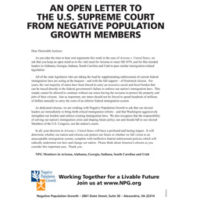The Meaning of Sustainability
- Albert Bartlett
- April 1, 2012
- Forum Papers
- Forum Paper
- 0 Comments
The Problem Stated
The problem is apparent at once. Reducing either P or A is completely contrary to the foundations of our religious and economic systems. We are given the impression by “experts” that both P and A must increase continuously if we are to have a “healthy society.” How small must P become to be sustainable? David Pimentel, a global agricultural scientist at Cornell University has estimated that a sustainable world population, living at the dietary level of the average American, is about 2 billion people.13 The world population in late 2011 is estimated to have reached 7 billion people and was growing at the rate of approximately 1% per year! The annual increase of world population in 2012 is thus something like 70 million per year.
[box type=”note”]stopping population growth and stopping the growth of rates of consumption of resources are both necessary, but are not sufficient, conditions for sustainability.[/box]
The Insufficiency Of Popular Prescriptions For Achieving Sustainability
Thousands of individuals and groups are working worldwide on hundreds of aspects of “sustainability.” When you look at this work you quickly conclude that all of the usual sustainability prescriptions are valuable, but when you add them all up their sum is much less than what is needed. The reason? All of these efforts fail to address overpopulation! These usual sustainability endeavors include all manner of big research projects and thousands of smaller efforts such as promoting the use of more efficient light bulbs, more efficient automobiles, more efficient homes, expanding and improving the efficiency of the national electric power transmission grid, etc.
Back To The Fundamentals: Malthus
Malthus observed some 200 years ago that population growth has the mathematical power to overcome the limited potential of increasing food supplies. By implication, the meaning of the message of Malthus is that, given sufficient time, population growth has the mathematical power to overcome or negate the limited advances that result from all of the technical achievements of our scientific and engineering establishments.
And if you’re wondering where do you get the greatest reduction in greenhouse gas emissions per dollar spent, it is interesting to note that one probably gets more reduction per dollar spent if you spend that dollar on family planning as compared to spending them on any of the “engineering type” solutions that are so popular and widespread. It has been estimated that a dollar spent on family planning will yield about five or more times the reduction of the emission of global greenhouse gases than you get when that dollar is spent on engineering “solutions” that are aimed at reducing the emission of greenhouse gases.14
Growth as the Centerpiece of Our Economy
In our custom of taking care of ourselves before we think of the future, we are supported by the overwhelming devotion of our society to endless growth which is often called “Sustainable Growth.” This oxymoronic concept is the centerpiece of our entire society, in which almost all leaders in our business, governing, and economic communities ignore or deny the existence of limits. The universality of the economic belief that there are no limits to growth gives the present generation reason to believe that there will always be plenty for future generations so that, as a consequence, we need not inconvenience ourselves now by accepting restrictions on our consumption or reductions in our population growth rates. As has been prominently asserted 15,
[box type=”note”]The american way of life is not negotiable![/box]
- Reflections on Sustainability, Population Growth, and the Environment - February 9, 2016
- The Meaning of Sustainability - April 1, 2012
- THOUGHTS ON IMMIGRATION INTO THE UNITED STATES - December 1, 2007

